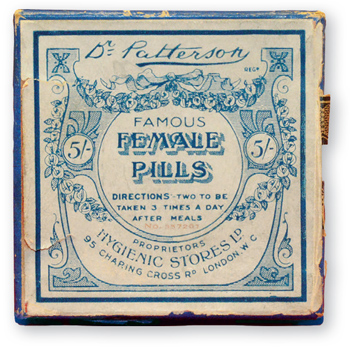
THE ‘FAMOUS FEMALE pills’ were sold through the Hygienic Stores, No. 95 Charing Cross Road, WC2, where the store’s literature described the pills as restoring ‘females to their usual health, when Penny Royal and Steel, Pil Cochiae, Bitter Apple &c. fail’. The ordinary price was 2s 9d, with ‘Special’ available at 4s 6d per box and ‘Special Strong for Obstinate Cases’ 11s and 21s. Customer testimonials included comments such as ‘I am pleased to be able to tell you that your pills were successful in relieving my wife of her trouble’. The Crime Museum’s collection also includes a black stethoscope, a rubber tube with a pump, aridone analgesic tablets, a uterine repository, curette spoon, a tin of pennyroyal, amenorone and various other items used for procuring illegal abortions.

Early–mid-1900s
Box of pills sold to induce abortions
Several items are in the museum from ‘The Great Harley Street Mystery’ of 1880. Pieces of embroidery, underwear, some hair and plaster casts of teeth survive from an investigation of a body of a woman found in a barrel of lime, in a cellar of a house in Harley Street. Medical examination revealed a stab wound in her left breast and concluded that death had occurred at least two years before the body was discovered. The victim was never identified and the case remains unsolved. The case was debated many years later by the Medico-Legal Society, with Sir Bernard Spilsbury proposing that the woman might have died as the result of an abortion, and that the abortionist had inflicted the stab wound after death as a method of diverting any post-mortem examination away from internal organs that would have revealed the true cause of her death.
Backstreet abortions were carried out in a completely unregulated manner prior to the Abortion Act of 1967 (when abortion was legalised), and there was a significant risk to the health and life of women who found themselves needing to terminate their pregnancy, often putting themselves at the mercy of untrained and inexperienced abortionists. The provisions of the 1967 Act almost eliminated this dangerous practice. Abortions are controversial and the Department of Health reported that the number conducted in England and Wales in 2011 reached 189,000.
One abortionist prosecuted in 1969 had a set of equipment so comprehensive that pathologist Professor Keith Simpson, a witness at the trial, thought that it should be displayed in the Crime Museum for police training purposes. The case had originated in September 1969 in a three-storey terraced house in Southampton Way, Peckham, where Matthew Okenarhe had advertised himself as an osteopath. Information had been given to the police that drugs were being kept under the bath at the house and that abortions were being performed there. When the police raided the house, they found phials of the drug ergot, a substance used for inducing abortions, a large number of gynaecological instruments and medical textbooks. Okenarhe, from Nigeria, had no medical training, and had been previously imprisoned for theft of mail and fraud in his former occupation with the Post Office. He had been collaborating with his brother-in-law Matthew Esegine, a local hospital porter, in attempting to perform abortions on a number of West Indian women who had been staying at a local boarding house for nurses run by Mrs Retornella Wright. He was convicted on fourteen counts of conspiracy to procure illegal abortions and of indecent assault on women by posing as a doctor. Okenarhe was sentenced to eight years’ imprisonment, Esegine was given four years, and Wright two years.